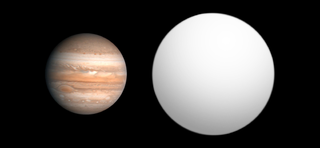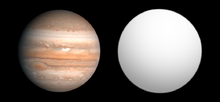
HD 80606 and HD 80607 are two stars comprising a binary star system. They are approximately 217 light-years away in the constellation of Ursa Major. Both stars orbit each other at an average distance of 1,200 astronomical units. The binary system is listed as Σ1341 in the Struve Catalogue of Double Stars; however, this designation is not in wide use and the system is usually referred to by the HD designations of its constituent stars. An extrasolar planet has been confirmed to orbit HD 80606 in a highly elliptical orbit.

HD 217107 c is an extrasolar planet approximately 64 light-years away from Earth in the constellation of Pisces. The planet was the second planet to be discovered orbiting the star HD 217107. HD 217107 c's existence was hypothesized in 1998 due to the eccentricity of the inner planet's orbit and confirmed in 2005 when radial velocity studies of the star indicated another, more distant and massive companion orbiting the star. The planet has an eccentric orbit lasting on order of a decade.

16 Cygni Bb or HD 186427 b is an extrasolar planet approximately 69 light-years away in the constellation of Cygnus. The planet was discovered orbiting the Sun-like star 16 Cygni B, one of two solar-mass (M☉) components of the triple star system 16 Cygni in 1996. It orbits its star once every 799 days and was the first eccentric Jupiter and planet in a double star system to be discovered. The planet is abundant in lithium.
HD 147506 is a magnitude 8.7 F8 dwarf star that is somewhat larger and hotter than the Sun. The star is approximately 419 light years from Earth and is positioned near the keystone of Hercules. It is estimated to be 2 to 3 billion years old. There is one known transiting extrasolar planet.

HAT-P-2b is an extrasolar planet detected by the HATNet Project in May 2007. It orbits a class F star HAT-P-2,, located about 420 light-years away in the constellation Hercules.
HD 17156, named Nushagak by the IAU, is a yellow subgiant star approximately 255 light-years away in the constellation of Cassiopeia. The apparent magnitude is 8.17, which means it is not visible to the naked eye but can be seen with good binoculars. A search for a binary companion star using adaptive optics at the MMT Observatory was negative.
HD 114762 b is a small red dwarf star, in the HD 114762 system, formerly thought to be a massive gaseous extrasolar planet, approximately 126 light-years (38.6 pc) away in the constellation of Coma Berenices. This optically undetected companion to the late F-type main-sequence star HD 114762 was discovered in 1989 by Latham, et al., and confirmed in an October 1991 paper by Cochran, et al. It was thought to be the first discovered exoplanet
HD 37605 is a star in the equatorial constellation of Orion. It is orange in hue but is too faint to be visible to the naked eye, having an apparent visual magnitude of 8.67. Parallax measurements yield a distance estimate of 153 light years from the Sun. It has a high proper motion and is drifting closer with a radial velocity of −22 km/s.
This page describes exoplanet orbital and physical parameters.

HD 80606 b is an eccentric hot Jupiter 190 light-years from the Sun in the constellation of Ursa Major. HD 80606 b was discovered orbiting the star HD 80606 in April 2001 by a team led by Michel Mayor and Didier Queloz. With a mass 4 times that of Jupiter, it is a gas giant. Because the planet transits the host star its radius can be determined using the transit method and was found to be slightly smaller than Jupiter's. Its density is slightly less than Earth's. It has an extremely eccentric orbit like a comet, with its orbit taking it very close to its star and then back out very far away from it every 111 days.

A circumbinary planet is a planet that orbits two stars instead of one. The two stars orbit each other in a binary system, while the planet typically orbits farther from the center of the system than either of the two stars. In contrast, circumstellar planets in a binary system have stable orbits around one of the two stars, closer in than the orbital distance of the other star. Studies in 2013 showed that there is a strong hint that a circumbinary planet and its stars originate from a single disk.

HAT-P-8b is an extrasolar planet located approximately 720 light years away in the constellation of Pegasus, orbiting the 10th magnitude star GSC 02757-01152. This planet was discovered by transit on December 5, 2008. Despite the designation as HAT-P-8b, it is the 11th planet discovered by the HATNet Project. The mass of the planet is 50% more than Jupiter while the radius is also 50% more than Jupiter. The mass of this planet is exact since the inclination of the orbit is known, typical for transiting planets. This is a so-called “hot Jupiter” because this Jupiter-like gas giant planet orbits in a really close torch orbit around the star, making this planet extremely hot. The distance from the star is roughly 20 times smaller than that of Earth from the Sun, which places the planet roughly 8 times closer to its star than Mercury is from the Sun. The “year” on this planet lasts only 3 days, 1 hour, 49 minutes, and 54 seconds, compared with Earth's 365 days, 6 hours, 9 minutes, and 10 seconds in a sidereal year.

HAT-P-14b, officially named Sissi also known as WASP-27b, is an extrasolar planet located approximately 224.2 ± 0.6 parsecs (731.2 ± 2.0 ly) away in the constellation of Hercules, orbiting the 10th magnitude F-type main-sequence star HAT-P-14. This planet was discovered in 2010 by the HATNet Project using the transit method. It was independently detected by the SuperWASP project.
HAT-P-17 is a K-type main-sequence star about 92.6 parsecs (302 ly) away. It has a mass of about 0.857 ± 0.039 M☉. It is the host of two planets, HAT-P-17b and HAT-P-17c, both discovered in 2010. A search for a binary companion star using adaptive optics at the MMT Observatory was negative. A candidate companion was detected by a spectroscopic search of high-resolution K band infrared spectra taken at the Keck observatory.
HD 146389, is a star with a yellow-white hue in the northern constellation of Hercules. The star was given the formal name Irena by the International Astronomical Union in January 2020. It is invisible to the naked eye with an apparent visual magnitude of 9.4 The star is located at a distance of approximately 446 light years from the Sun based on parallax, but is drifting closer with a radial velocity of −9 km/s. The star is known to host one exoplanet, designated WASP-38b or formally named 'Iztok'.









